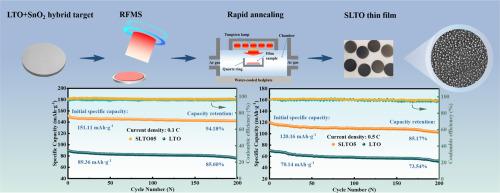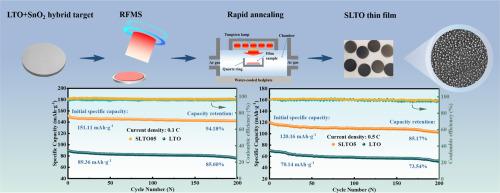自组装三维纳米球Sn-SnO2/Li4Ti5O12复合薄膜负极材料及其在准固态薄膜电池中的应用
IF 9.3
1区 材料科学
Q1 MATERIALS SCIENCE, MULTIDISCIPLINARY
引用次数: 0
摘要
采用射频磁控溅射技术和快速退火处理,制备了具有自组装Sn-SnO2纳米球的三维Sn-SnO2/Li4Ti5O12复合薄膜负极材料。x射线衍射分析表明,薄膜主要由多晶Li4Ti5O12组成,少量单晶Sn和SnO2。扫描电镜结果显示,退火后的薄膜在复合材料表面嵌入了纳米球形颗粒。电化学阻抗谱表明,在优化条件下(退火温度850℃,SnO2/Li4Ti5O12摩尔比0.5),复合膜的电荷电导率为1.41 × 10-6 S·cm-1。恒流间歇滴定技术分析表明,在半电池结构下,锂离子的动态扩散系数为2.09 × 10-13至1.23 × 10-11 cm2·s-1。原位XRD表征表明薄膜在充放电循环过程中具有优异的结构可逆性和稳定性。该复合膜在0.1℃和0.5℃下的初始放电比容量分别为151.11 mAh·g-1和120.16 mAh·g-1,循环200次后容量保持率分别为94.18%和85.17%。随后,采用Li1.3Al0.3Ti1.7(PO4)3和LiFePO4组装准固态电池,初始比放电容量分别为115.29 mAh·g-1 (0.1 C)和86.55 mAh·g-1 (0.5 C),循环200次后容量分别为85.94%和80.37%。这项工作为开发高性能3D锂离子薄膜负极材料提供了有价值的见解。本文章由计算机程序翻译,如有差异,请以英文原文为准。


Self-assembled three-dimensional nanosphere Sn-SnO2/Li4Ti5O12 composite thin film anode materials and their application in quasi-solid-state thin film batteries
Three-dimensional Sn-SnO2/Li4Ti5O12 composite thin film anode materials, featuring self-assembled Sn-SnO2 nanospheres, are effectively fabricated through radio-frequency magnetron sputtering technology followed by a rapid annealing treatment. X-ray diffraction analysis shows that the film predominantly consists of polycrystalline Li4Ti5O12, along with minor monocrystalline Sn and SnO2. Scanning electron microscopy results reveal that post-annealed films exhibit nanospherical particles embedded within the composite surface. Electrochemical impedance spectroscopy demonstrates a charge conductivity of 1.41 × 10-6 S·cm-1 for the composite film under optimized conditions (annealing temperature: 850 °C, SnO2/Li4Ti5O12 molar ratio: 0.5). Galvanostatic intermittent titration technique analysis reveals a dynamic Li-ion diffusion coefficient ranging from 2.09 × 10-13 to 1.23 × 10-11 cm2·s-1 in a half-cell configuration. In situ XRD characterization highlights excellent structural reversibility and stability of the film during charge/discharge cycles. The composite film delivers initial discharge specific capacities of 151.11 mAh·g-1 at 0.1 C and 120.16 mAh·g-1 at 0.5 C, with capacity retention rates of 94.18% and 85.17%, respectively, after 200 cycles. Subsequently, Li1.3Al0.3Ti1.7(PO4)3 and LiFePO4 are employed to assemble a quasi-solid-state battery, achieving initial specific discharge capacities of 115.29 mAh·g-1 (0.1 C) and 86.55 mAh·g-1 (0.5 C), with 85.94% and 80.37% capacity after 200 cycles. This work provides valuable insights for developing high-performance 3D Li-ion thin-film anode materials.
求助全文
通过发布文献求助,成功后即可免费获取论文全文。
去求助
来源期刊

Acta Materialia
工程技术-材料科学:综合
CiteScore
16.10
自引率
8.50%
发文量
801
审稿时长
53 days
期刊介绍:
Acta Materialia serves as a platform for publishing full-length, original papers and commissioned overviews that contribute to a profound understanding of the correlation between the processing, structure, and properties of inorganic materials. The journal seeks papers with high impact potential or those that significantly propel the field forward. The scope includes the atomic and molecular arrangements, chemical and electronic structures, and microstructure of materials, focusing on their mechanical or functional behavior across all length scales, including nanostructures.
 求助内容:
求助内容: 应助结果提醒方式:
应助结果提醒方式:


